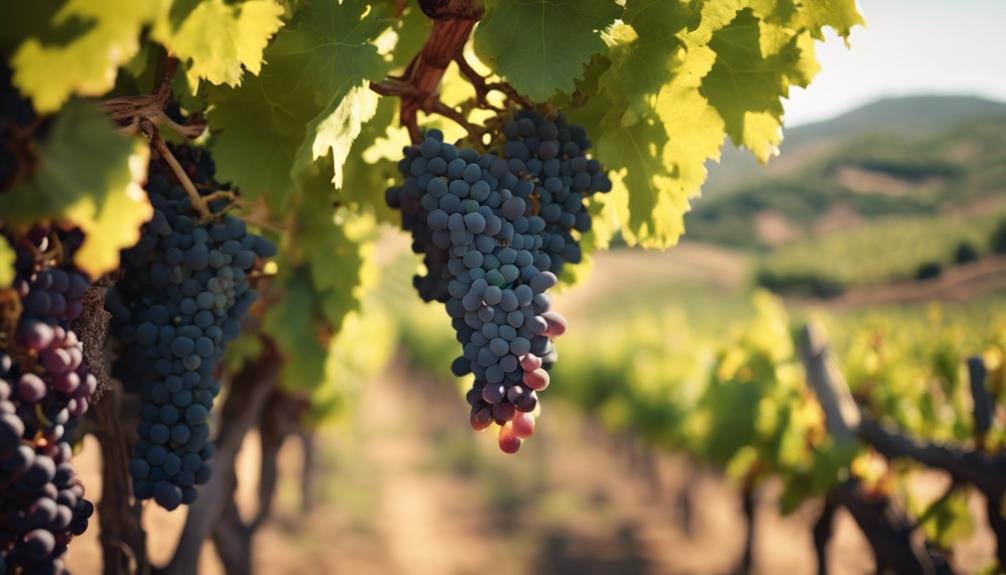Uncover the allure of Albariño wine, a premium white with vibrant acidity and invigorating citrus notes. Pair with seafood to cleanse the palate. Tasting reveals lemons, limes, and honeysuckle, finishing with a tangy zest. Serve chilled for best enjoyment, possibly warming slightly for intensified flavors. Perfect for dishes with aromatic herbs, enriching the citrus tones. Originating from Galicia, Spain, this wine thrives in cooler, wetter climates, giving it a unique edge. Discover the secrets behind Albariño's profound complexity and be captivated by its invigorating character, ideal for a range of culinary delights.
Albariño Wine Characteristics
Known for its high acidity and invigorating citrus flavors, Albariño wine is a premium, light-bodied white wine mainly cultivated in Spain and Portugal. This wine offers a dry taste with subtle saltiness, making it a perfect match for seafood dishes like ceviche and fish tacos.
The high acidity and slight bitterness of Albariño cleanse the palate, making it an excellent pairing with light to middle intensity foods and white meats. Additionally, its compatibility with dishes featuring citrus and aromatic herbs enhances the overall dining experience.
Albariño's flavor profiles include aromas of lemons, limes, pear, grapefruit, honeysuckle, and nectarine, complemented by subtle notes of wet granite and Thai basil. These characteristics make Albariño a versatile and invigorating choice for various culinary pairings.
Albariño Tasting Notes
With a dramatic aromatic intensity driven by terpenes and thiols, Albariño wine captivates the senses with a bouquet of vibrant citrus and floral notes. This high-quality white wine offers aromas of lemons, limes, pear, grapefruit, honeysuckle, and nectarine, accompanied by subtle hints of wet granite and Thai basil. Its mouth-watering acidity, weighty mid-palate, and touch of saltiness lead to a long, tingly finish with a subtle bitter note reminiscent of grapefruit pith. Below is a table showcasing the tasting notes of Albariño wine:
| Aromas | Description |
|---|---|
| Citrus | Lemons, limes, grapefruit |
| Nectarine | Sweet, ripe nectarine |
| Honeysuckle | Floral, sweet aroma |
| Wet Granite | Earthy, mineral notes |
| Thai Basil | Herbal, aromatic touch |
Serving Albariño Wines

When serving Albariño wines, it is vital to consider the ideal temperature and glassware for enhancing the unique flavors and characteristics of this high-quality white wine. Albariño wines are best enjoyed when served cold in a white wine glass, allowing the aromas and flavors to shine.
However, you can experiment by letting the wine warm up slightly to enhance flavors, ranging from minerally to richer fruit notes. It's crucial to mention that Albariño tends to taste lighter in body compared to other white wines, making it a versatile option for various occasions.
For the best enjoyment, consider consuming Albariño 1-2 years after vintage, as this timeframe ensures trademark acidity and fruity aromas are at their peak, enhancing your overall experience.
Food Pairing With Albariño
Albariño wines complement a wide range of dishes, particularly those featuring seafood and aromatic herbs. When it comes to food pairing with Albariño, seek flavorful pairings that enhance its high acidity and invigorating citrus flavors.
This wine's versatility allows for pairing with a variety of culinary delights, especially seafood dishes like ceviche, fish tacos, and white meats. The high acidity and slight bitterness in Albariño cleanse the palate, making it an ideal match for light to middle intensity foods. Dishes featuring citrus and aromatic herbs are particularly enhanced by the characteristics of Albariño.
Consider exploring Vietnamese, Thai, Californian, Sushi, and Caribbean seafood cuisines to experience the full potential of this wine's compatibility with different flavors.
Albariño Geographical Origin

Originating primarily in the Iberian peninsula, the cultivation of Albariño grapes is particularly concentrated in Galicia, Spain. This region is known for its cooler, rainier climate, which provides the ideal conditions for growing these grapes. Albariño wines from Spain are commonly labeled from the Rías Baixas region.
Additionally, in Portugal, Albariño is often associated with the Vinho Verde region. While Galicia and Vinho Verde are the primary areas for Albariño production, this grape variety has also found success in regions like California, Argentina, New Zealand, Brazil, and Uruguay.
The spread of Albariño internationally can be attributed to its high quality and similarity to other popular white wines, making it a sought-after choice for wine enthusiasts worldwide.
Frequently Asked Questions
Can Albariño Wines Be Aged for Several Years to Improve Flavor?
Albariño wines can be aged for several years to enhance flavor development. While they are typically enjoyed young for their trademark acidity and fruity aromas, some high-quality Albariños can benefit from aging, evolving with time to offer richer and more complex tasting profiles.
Are There Any Specific Regions in California Known for Producing Albariño Wines?
California vineyards showcase diverse Albariño production, notable for regional variations. Central Coast regions like Santa Barbara and San Luis Obispo excel in crafting Albariño wines with distinct characteristics, embracing the grape's Spanish roots while adding their unique terroir influence.
What Is the Best Way to Store Albariño Wines to Maintain Their Freshness?
To maintain Albariño wines' freshness, store them in a cool, dark place lying on their side to keep corks moist. Serve chilled in a white wine glass for best taste. Proper storage preserves this wine's vibrant acidity and citrus notes.
Are There Any Organic or Sustainable Albariño Wine Producers to Support?
Several Albariño wine producers embrace sustainable practices and hold organic certification. By supporting these producers, consumers can enjoy environmentally friendly wines that prioritize ethical farming methods. Look for labels indicating organic or sustainable practices for conscientious choices.
Can Albariño Wines Be Used in Cooking or as an Ingredient in Recipes?
Albariño wines can enhance culinary creations by adding bright acidity and citrus notes. Ideal for deglazing pans, marinating seafood, or infusing sauces. Pair with dishes featuring citrus, seafood, and aromatic herbs for a delightful dining experience.
Conclusion
In the world of wine, Albariño stands out as an enchanting choice with its invigorating acidity, citrus flavors, and subtle saltiness. This exquisite white wine, originating from Spain and Portugal, offers a sensory journey of lemons, limes, and delicate floral hints.
When enjoyed chilled, Albariño's nuanced profile shines through, making it a versatile option for pairing with seafood dishes. As you savor a glass of Albariño, let its vibrant flavors transport you to sun-kissed vineyards and coastal breezes.
